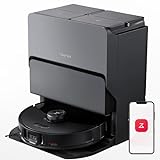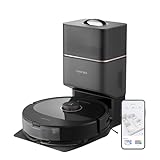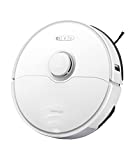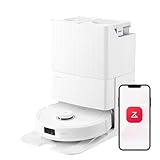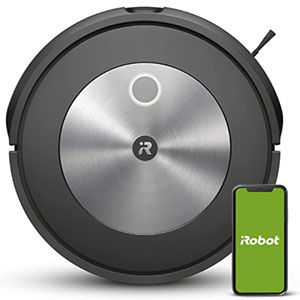Roborock Q7 vs. Q8 – Comparison Review
Roborock Q7
Roborock Q8
Roborock Q7

- Dimensions 13.78"L x 3.8"W x 13.9"H
- Weight 25 pounds

Roborock Q8

- Dimensions 13.8"L x 17.3"W x 17.6"H
- Weight 17.9 pounds
Roborock Cyber Monday 2025
Modern people value their free time and prefer to enjoy life, not spend hours on housework. That is why all automation equipment has become so popular – washing machines, dishwashers, coffee machines, slow cookers, and robot vacuum cleaners. You can automate all aspects of your life nowadays and include all electric equipment in a “smart” home. You can control all devices, lights, curtains, and sockets with your voice or smartphone application. It is convenient and provides many free time for more exciting activities.
In this article, we will review two Roborock best-sellers – Roborock Q7 vs. Q8. We will compare to Max+ models with a base station. These cleaners promise hands-free vacuuming and mopping with a self-emptying docking station, extended runtime, and powerful suction. Even though Roborock is a new company founded in 2014, its products already become one of the most respected ones and the latest cleaning algorithms, mechanical structure design, and electrical engineering.
Check Price
Roborock Q7 vs. Q8 – Face-to-Face Comparison

The Q7 has a round shape with a vertical bumper with a 13-sensor sensient array to locate the robot accurately during cleaning. The dimensions are 353*350*96.5 mm. This array has a set of cliff sensors, bumpers, accelerometers, and others.
The Q7 can climb the carpet 2 cm/0.8 inches in height (the same for the Q8). For moving, the robot uses two rubber and one plastic wheel. It has a Child Lock protection to protect the robot from accident start.
The lid has three buttons: dock, clean/power, and spot clean/child look. To activate the child lock, you need to press the button for 3 seconds.
The robot with LED indicator light provides the current status: blue – vacuuming and mopping, white – vacuuming, green – docking/ recharging, orange – alert. The Q7 Max+ is available in two colors – black and white.
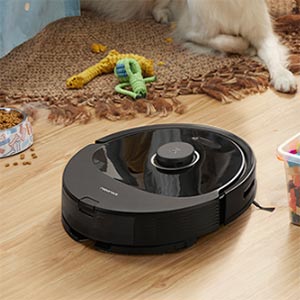
The Q8 is a round-shaped robot cleaner in black and white colors. Its dimensions are 350*353*96.5 mm and precisely the same as the Q7 model.
In front, the plastic bumper with integrated dust and water container is located, which protects the sensitive parts from damage.
The number of wheels to move is the same. On the shining lid, there are several buttons – power/clean, spot clean/child lock, and dock.
The LED indicator provides several statuses: white – battery level higher than 20%, red – battery level less than 20%, pulsing – charging or starting up, and flashing red – error. The Child Lock function is available for this model as well.


The appearance of two robot cleaners is similar. There are no differences in dimensions, fast buttons on the lid, bumper on the top, and shape. There is a slight difference only in LED status lights and the lid. So, there is no winner in this part of the comparison of Roborock Q7 vs. Q8.

The Q7 possesses twin cleaning power with simultaneous vacuuming and mopping. The maximum mopping range is 150 sqm, vacuuming the maximum range is 300 sqm.
You can set no-go zones and invisible walls in the application to prevent the robot from going there. The ideal home size for this robot cleaner is up to 300 m2 (3230 sq ft). The robot has three modes: vacuum, mop, or both vacuum and mop simultaneously.

The Q8 has the functionality of a vacuum and mopping cleaner. You can choose in the app the mode with cleaning along the floor direction. You can set invisible walls to protect expensive carpets or furniture.
Also, it has smart suggestions for no-go zones for stairs and easy-to-stuck places. All sensors prevent accidents, falls, and mishaps. The robot is designed to clean up to 3000 sqm (3230 sq ft) with one battery charge.


In the comparison per this parameter, the Q8 we can call the winner, as it has the function of smart no-go zones with the same options for cleaning and mopping, especially the maximum cleaning surface.

The suction power of the Q7 can reach 4200 in Max mode to clean trapped dust in your floors and carpets. It automatically turns max mode when it detects carpets automatically.

With a high power of 5500 Pa, the Q8 leaves no space for dust and dirt to hide. The robot has four cleaning modes (quiet, balanced, turbo, and max).
MAX+, with a maximum power of 5500 Pa, is recommended for deep cleaning only (especially on carpets) to prolong battery capacity.


Higher suction power makes the Q8 the leader in this round.

Adjustable 30 water flow levels control the mopping performance of the Roborock Q7 to leave your floors gleaming.
On the bottom is installed one VibraRise mopping cloth mount with a cloth that wipes hard floors with 300g consistent mop pressure when moving around the house. The built-in electronic tank is 350 ml, which is enough to mop 2583 sqft (240 sqm).

The mopping capabilities of the Roborock Q8 are the same as those of the Roborock Q7. It also has 30 water floor levels to clean even stubborn stains on hard floors.
The electronic water tank for 350 ml is enough to mop 2960 sq ft (275 sqm). You can set a low level for stone cleaning or a high-flow for kitchen tiles.


There are no differences in the mopping performance of the two models; we don’t have a winner.

The Roborock Q7 Max+ has a docking station with the robot’s built-in dustbin auto-empty feature. The dimensions are 306*442*425 mm.
All dust is collected into a 2.5 L disposable dust bag that can hold it for up to 7 weeks. The bag holds up to 99.7% of pollen (up to 0.3 microns) and is an effective air filter; moreover, it is removed in several seconds.

The Roborock Q8 Max+ has a charging station with the function of a hands-free, self-emptying dust bin. It stores all dust for up to 7 weeks in a 2.5L disposable E12-rated dust bag.
But the actual change of dust bags depends on cleaning habits and the environment. You can set the time when you want to empty the dustbin, as this is a 10-second noisy process. The Rock Dock Plus dock station (dimensions are 305*440*448 mm) is a unique station only for the Q8 Max + model.


The Q8 and Q7 have different dimensions but similar functionality – charging station and auto-empty dustbin. The Q8 has the additional feature of postponing emptying the dustbin, making it more convenient. So, the Q8 is the winner.

The Roborock Q7 has a Precise LiDAR navigation system to create maps of your house. It has adaptive route algorithms to calculate the most efficient cleaning route based on the room shape and furniture inside.
Laser navigation allows to map objects up to 2 cm tall. With SLAM, the robot localizes itself and creates maps.

The Roborock Q8 has an upgraded navigation PreciSense LiDAR system with reactive tech obstacle avoidance. You don’t need to clean the objects from the floor before starting cleanup.
Its adoptive route algorithms help change the cleaning routes depending on the necessities. To localize precisely, the robot uses a sensient sensor array on top of the robot (the same as for the Q7).


For better obstacle avoidance, we again choose the Q8 as the winner in comparing Roborock Q7 vs. Q8.

The Q7, using an advanced navigation system, performs quick mapping for houses up to 4 levels without cleaning up to 6 times faster than budget cleaners. All rooms are available in 3D, where you can add furniture and set floor materials for a better presentation of your home.
You do not need several docking stations for cleaning on different levels. You need only to bring the robot up or down the stairs. You can also scan the map of your home and save it.
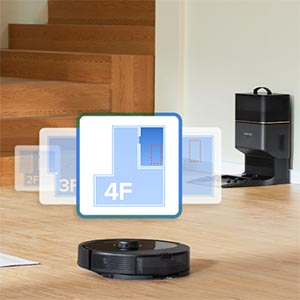
The Q8 maps precisely your home for further customization in the app. It maps 6x times faster with the function of quick mapping and creates a 3D visualization of your home. You can choose the representation in 2D or 3D, change floor types, and add furniture. It is possible to map up to 4 levels.


As you see, there is no difference in maps created by both cleaners. There is no winner.
The Q7 filter is rated E11 and can hold particles inside the dustbin. The filter is washable, which extends its service life.
The Q8 filter is rated E12 and can be washed with fresh water or cleaned with a soft-bristle brush. You can also vacuum it with a standard vacuum cleaner if you have one.


The Q7 and the Q8 have HEPA filters. But the E11 filter can hold 95% of 0.2-0.4 dust particles, while E12 can hold at least 99.5%. So, the Q8 is the winner.
The Q7 is equipped with a red multi-directional floating main brush that agitates and gathers up all dust and dirt from hard floors and carpets.
All dust is sent to the built-in dustbin with vacuum airflow, while the rubber fins are resistant to hair tangling.
The floating function keeps the brush as close to the floor as possible. On one side, the plastic edge brush is installed for cleaning hard-to-reach corners.
The Q8 is equipped with one red and one black DuoRoller Brushes to capture hair and dust.
These brushes pick up to 20% more hair and dust in one run than a standard brush. The double rollers are the latest Roborock technology to enhance cleaning performance on carpets without hair tangles.
Moreover, the wheels and brushes are scratch-free. The edge plastic brush is installed to clean corners on the right side.


We definitely recommend in this round the Q8 because of the better cleaning performance and dust/hair picking by DuoRoller brush.
The Q7’s capacity of built-in dustbin is 470 ml, enough for large homes. It is washable with tap water. The dustbin tank is combined with a water tank to increase both capacity and simplify maintenance.
The Q8 does not differ in a dustbin. It also has a capacity of 470 ml, combined with a 350 ml water tank for easier cleaning and refilling.


There is no difference in the combined dustbin and water tank, so it is no winner.

The Q7 can be controlled with a smartphone application or voice control devices. Using a smartphone application, you can create customized paths to highlight areas for immediate cleaning and real-time location of your robot.
One of the popular features is setting repeated schedules by choosing cleaning time, suction power, or the required rooms for cleaning. You can control your voice using devices with Apple Siri, Amazon Alexa, Google Home, or an integrated voice pack for stop and start (available in English, German, Spanish, French, and Chinese).
The robot is automatically updated without connection to the smart devices; the connection to Wi-Fi is only required.

The Q8 is controlled via smartphone apps and voice programs as well.
You can customize your cleaning routine by setting a time (after meals or while you are away), cleaning vacuum and mop mode, and quantity of rooms, and the process will start automatically.
For you also available fast cleaning mode, the robot chooses the fastest cleaning paths to save 30% of your time.
To start the device, you can use a voice pack (the same as for the Q7) or Alexa/Google Home/Siri. The Q8 supports only 2.4G WiFi (the same applies to the Q7).


Even though the control possibilities of the two models are the same, the fast cleaning mode is available only for the Q8. We can call the Roborock Q8 Max+ the winner.

The Q7 can clean for 60 minutes in max mode (with the highest suction power), which equals 1076 sq ft area. It works for 120 minutes in auto mode, which equals 2152 sqft. In quiet mode, it cleans for 180 minutes – 3230 sq ft.
After finishing the cleaning cycle, the robot automatically returns to the charging (base) station. If the battery (5200 mAh) is low before the end of the cycle, the robot goes to the charging station to recharge up to 80% and resume cleaning.

Even though the Q8 has the same 5200 mAh, the cleaning process is optimized for a maximum runtime of 240 minutes in quiet mode without interruption. To reduce electricity bills, this model has off-peak night or morning schedules. Charging time is 6 hours.


The Q8 offers the owners prolonged cleaning time with the same battery capacity, in addition to the off-peak night charging; this model prevails in this round. Meanwhile, the Q7 has the possibility of 80% charging to resume for cleaning further. So, in this round, we have no winner.
The Roborock Q7 Max+ comes with:
- Q7 robot vacuum
- Base station
- Mop cloth mount and cloth
- Moisture –proof mat
- Electric water tank combined with dust bin
- User manual
- Power cable
The Roborock Q8 Max+ comes with:
- Q8 robot vacuum
- Base station
- Mop cloth mount and cloth
- Electric water tank combined with dust bin
- User manual
- Power cable
Cleaning tests:
Vacuuming Performance on Bare Floors
The cleaning test is the most interesting part of our comparison of Roborock Q7 vs. Q8. These tests show how these cleaners’ performance differs during vacuuming and mopping the hard floor and carpets.
Vacuuming Performance on Bare Floors
- Saw Dust
- 97%
- 98%
- Flour
- 97%
- 98%
- Rice
- 96%
- 98%
- Sugar
- 95%
- 97%
- Cheerios
- 96%
- 96%
- Kitty litter
- 96%
- 96%
- Pet hair
- 94%
- 95%
- Sand pebbles
- 95%
- 97%
Vacuuming Performance on Carpets
Vacuuming Performance on Carpets
- Saw Dust
- 95%
- 95%
- Flour
- 96%
- 97%
- Rice
- 95%
- 96%
- Sugar
- 96%
- 96%
- Cheerios
- 96%
- 96%
- Kitty litter
- 95%
- 96%
- Pet hair
- 95%
- 95%
- Sand pebbles
- 95%
- 96%
Mopping Performance on Bare Floors
Mopping Performance on Bare Floors


The result of tests is mainly determined by dual brushes and the higher suction power of the Roborock Q8, which showed better results in all cleaning tests. Nevertheless, the Q7 is very close in performance.
Check Price
Maintenance
The maintenance of the Roborock Q7 Max+ and Q8 Max+ has no difference. You must regularly maintain your Roborock models to keep them in good shape and work efficiently.
For that, you need to execute several regular habits:
- The main brush should be cleaned with a wet cloth and not dried in direct sunlight every 2 weeks; replace it every 6-12 months.
- The side brush should be cleaned every month and replaced every 3-6 months.
- The main wheels on the bottom should be cleaned once a month.
- The combined dustbin and water tank unit should be cleaned weekly; no replacement is required.
- The filter should be cleaned weekly and replaced every 6-12 months.
- Mop cloth should be cleaned and air-dried after each use and replaced every 6-12 months for the Q7 and the Q8 every 3-6 months.
- Robot sensors (dock locator, wall sensor, and cliff sensors) and charging contacts should be cleaned monthly; no replacement is required.
All other parts, such as the omnidirectional wheel and air duct, should be cleaned as required. The disposable dust bag should be changed to the new one as required. The battery should be charged for regular use; if you unuse the robot for an extended period, you must turn it off and charge it at least once every three months.
Verdict
Frequently Asked Questions
How can I set no-go zones for the Roborock Q7?
How can I schedule my Q7 if it does not work through the application?
How can the spot cleaning button be used on the Q7 and the Q8 models?
Do I need to use cleaning liquids while maintaining the Roborock Q8?
Do the Roborock cleaners have the do not disturb mode?
Which vacuum and mop cleaner is the best: Roborock Q7 or Q8?
We hope that our detailed comparison of Roborock Q7 vs. Q8 showed how close these two models are. The Q8 Max+ has won this competition in several parameters: smart no-go zones, higher suction power, dual main brush, more precise obstacle avoidance, better filter, fast cleaning mode, and prolonged runtime. But the price of Q8 is higher, so if you are on a tight budget, look closely at the Q7 model. It can mop and vacuum simultaneously, has similar mopping performance, has good navigation and mapping features, and works for 180 minutes on a single charge. Both robotic vacuum cleaners are good investments in your free time!



